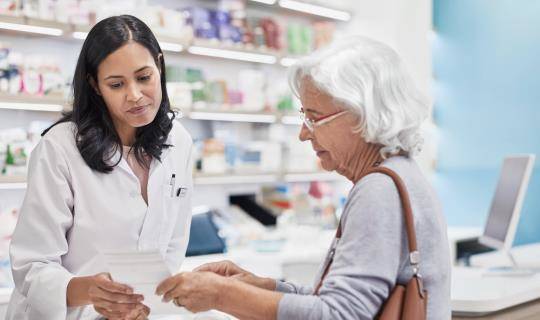Women gain ground at pharmacy's forefront
By AmerisourceBergen
Women pharmacists are a professional force on the rise among American healthcare workers. While 36 percent of U.S. physicians are female, up 8% over a 12-year span, women pharmacists have made even more dramatic gains.
Among the 300,000 actively practicing U.S. pharmacists, more than 65% are female. Consistent with that demographic split — and indicative of the workforce’s future — women earned approximately 63% of the 14,300 PharmD degrees conferred at U.S. pharmacy schools in 2020.
Additionally, women currently represent 54% of U.S. “pharmacist-in-charge” positions, up from 42% as recently as 2018, with only a 2% gender pay gap compared to their male counterparts.Across all full and part-time workers in the U.S., males typically earn 17% more than females.
So, what makes women pharmacists well-suited for such a powerful presence?
For starters, consumers rate pharmacists at a 10-year high for their honesty and ethical standards. That foundational sense of trust serves female pharmacists particularly well in their interactions with women consumers, who make 80% of healthcare buying and usage decisions for their families.
Jennifer Urso, pharmacist and co-owner of Gateway Pharmacy in Phoenixville, Pa., explains the connection: “The combination of being naturally empathetic and having a medical background is extremely empowering and can help so many people. This is especially important in a retail setting, where we often see patients who have trouble accessing medical care.”
Vital connection to the community
October’s observance of Women Pharmacist Day and American Pharmacists Month celebrates the significant gains that women have made in pursuing careers in pharmacy and the profession’s role in keeping communities healthy, with nearly 90% of the U.S. population living within 5 miles of a pharmacy. Over the past two years, female and male pharmacists served essential functions during the COVID-19 pandemic, when they provided more than half of U.S. vaccinations, and administered antibody products and antiviral medications for an estimated 1 million additional patients.
“Pharmacists have always played a critical role in our healthcare system,” comments Jenni Zilka, President of Good Neighbor Pharmacy. “The pandemic simply put a spotlight on the importance of pharmacists and pharmacies, especially as accessible healthcare providers and destinations nationwide.”
And as the pandemic edges toward endemic stage, when it rarely causes severe disease, healthcare leaders increasingly look to an inclusive workforce for innovations in patient care. “Women have unique experiences and skills, and often process things differently than their male counterparts,” comments Melanie Joe, PharmD, Associate Director for Pharmacy Professional Affairs at University of California, Irvine’s School of Pharmacy. “Women can play an integral role in driving innovation in pharmacy and healthcare by drawing upon their strengths.”
Building on a legacy of achievement
While rising to the forefront of the profession, contemporary women pharmacists owe a debt of gratitude to their groundbreaking predecessors. Luminaries recognized by the APhA Foundation include:
- Elizabeth Greenleaf, recognized as America’s first female pharmacist, who owned an apothecary in Boston in the early 1700s.
- Mary Jacobi, the first woman to graduate from a school of pharmacy (1863).
- Nellie Wakeman, the first woman to receive a PhD degree in a pharmacy discipline (1913).
- Sister Mary Duffy, the first woman to serve as president of the American Society of Hospital Pharmacists (1978).
- Mary Runge, the first woman and first African American to become president of APhA (1979).
Despite these continuous breakthroughs, many women pharmacists reported on-the-job gender bias as recently as 2015.
What the future holds
Considering female pharmacists’ majority status among active practitioners, pharmacy ownership represents a viable pathway to break free from gender bias. As of 2021, 49% of new businesses in the U.S. were started by women, a drastic uptick since 2019. Data from companies across a range of industries show that organizations with more diverse workforces perform better financially.
Accordingly, female pharmacists continue to explore and learn about the benefits of owning a community pharmacy. Due diligence should encompass thorough understanding of how to operate a business, manage financials and cash flow, and develop employees — all while upholding the highest standards for patient care.
Similarly, female pharmacy owners urge female pharmacists to maintain an open mindset. “In today’s world, you can be successful with hard work and determination,” observes Krista Gibson, pharmacist and co-owner of Gibson’s Pharmacy in Dodge City, Kan. “Your career path may not always be easy, but I would encourage all women to stay focused and continue to work hard for whatever they would like to accomplish.”
Amber Haag, owner and pharmacist-in-charge at Haag Pharmacy in Emporia, Kan., adds, “The glory of a pharmacy is that you can change and contribute as much or as little as you want. The opportunity to assist and serve our patients and communities will always continue, as will the need for quality patient care, regardless of the setting.”
Learn more
Knowing where to get started on how to open your own independent pharmacy can be overwhelming.
If you’re looking to open your own independent pharmacy, our Pharmacy Ownership team would love to help. Maybe you’re just ready to grow your business through expanding in-store retail experience or patient care services. Our business coaches would love to partner with you!




